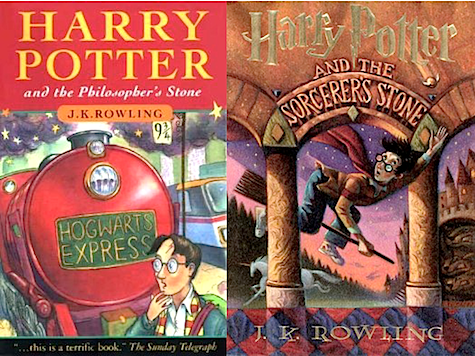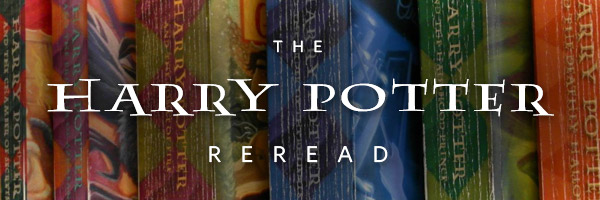It’s going on two decades since the very first child picked up a book emblazoned with Harry Potter’s name, and the world of children’s literature, fantasy, and fandom has never been the same. Rowling’s wizarding world shaped a generation of young people and her series holds the distinction of being nothing short of a global phenomenon. Children read because of Harry. Friendships were formed because of Hogwarts. The quilt of pop culture will forever display that lightning-shaped scar somewhere amidst its patches.
But how long has it been since you walked those halls in print? For my part, it’s actually been a while, and I’m starting to feel it. Get your feet in those broom stirrups, everyone—I mean to reread, and no one on this here earth can stop me.
This is going to go pretty simply—we’ll start with the first book, which I’m going to refer to by it’s original title (The Philosopher’s Stone) because even if I am American, the change they made to the U.S. edition actually hurts Rowling’s mythology-building and makes no sense. I will show the U.S. covers, however, because they were all rendered in a now-iconic style by a single artist. So there you have it. Though Rowling herself suggested the change at Scholastic’s request, she admits now that if she’d had more clout at the time, she wouldn’t have stood for it. Of course, I possess the U.S. editions of most of the books, so some of the quotes might be ever so slightly off due to Americanisms.
Standard format applies: I’ll give the summary of a chapter (one to two per post depending on length), then reactions and discussion-worthy topics after. Hope that works for everyone!
Keep in mind this is a reread—which means that I’m assuming everyone involved has read the books and won’t mind spoilers for what comes up. It’s been a while since I’ve read the series myself, especially the earlier books, so if I happen to forget where certain subplots and such are headed… well, that’s just bound to happen. Be kind, everyone! And that goes for being kind to each other as well, of course.
Also: sometimes we might take a break from the schedule if one of the topics unearthed in rereading requires enough examination for an essay of some kind. So that’s on the table as well!
Since we’re starting a book that has a lot of history attached to it, I figured I’d kick us off with some—
Background

J.K. Rowling came up with the idea for Potter in 1990, obtaining a grant to finish it from the Scottish Arts Council in 1996. Though she never wrote the book on the back of coffee shop napkins, as legend would have it, she did fall on some very rough times during her years writing the book. The death of her mother saw Rowling transfer some of her own grief onto Harry’s character as a orphaned boy, and she had very little money at the time while raising a daughter on her own.
Her publisher, Bloomsbury, did indeed recommend that Rowling change her penname to “J.K.” so that boys would be less daunted—because we still sadly live in a society where many boys (and men) think reading books by women is somehow not cool. Philosopher’s Stone was first published in June of 1997 in the U.K., then by Scholastic under the new title in the U.S. in September 1998, and the rest is history. The illustrations in the initial U.K. edition were done by Thomas Taylor, and the illustrations for all of the U.S. books were done by Mary GrandPré.
Alright, Hogwarts alums! It’s time to get a move on and dive right into chapter one….
Chapter One—The Boy Who Lived
Summary
The Dursleys are a very normal family who live at Number 4 Privet Drive. Vernon Dursley sells drills for a living and Petunia Dursley spends her time looking after their infant son Dudley, who is something of a terror already. The Dursleys live in fear that someone might find out about Mrs. Dursley’s sister, who is decidedly abnormal in some way, and also incidentally married with her own infant son.
One morning, Mr. Dursley heads off to work and notices that strange things are happening all over the place. There is a cat reading signposts outside his home, owls all over, and people walking about in colorful robes. They are whispering about “The Potters”—the surname of Petunia’s sister and her family. He mentions this to his wife in the evening, though he knows it won’t please her. She hasn’t heard from her sister recently, so the family goes to bed unconcerned.
That night, Professor McGonagall (who had been disguised as the cat outside the Dursley’s house) meets with Professor Dumbledore to find out the truth about the Potters. It would seem that someone very bad named Voldemort has been defeated, and though no one seems sure exactly how this occurred, it was just-over-a-year-old Harry Potter who stopped him; he received a lightning-shaped scar on his forehead as a souvenier. His parents, James and Lily, died in the attack. Dumbledore’s plan is to have Harry brought to Number 4 Privet Drive to live with his aunt and uncle. Professor McGonagall is against placing Harry in their care, noting that she has observed the Dursleys all day and finds them horrid. Dumbledore insists that this is the safest place for baby; the Dursleys are the only living relatives he has left, and it is best for the boy to grow up away from “their world” where everyone will know his name.
Hagrid, a giant bear of a man, arrives with Harry on a flying motorbike that he borrowed from Sirius Black. He hands the boy over to Dumbledore, who places him on the Dursley’s doorstep. He, McGonagall, and Hagrid leave him there to be found the next morning. Poor Harry Potter has no idea that he is currently being toasted all over the country and beyond as “The Boy Who Lived.”
Commentary
You know… Rowling is really damn funny.
I feel like she gets piled on for having a style that is anything but flowery and poetic, and people miss her sense of humor, which is always so on point and effortless. How she introduces us to the Dursleys is reminiscent of many great authors from Roald Dahl (more Dahl-like in the upcoming chapters) to Charles Dickens to Jane Austen, yes, but still unique to her and very modern. The scathing judgment she allows the reader to pass on the family without having the narrative be outright scornful toward them is marvelous. The way she describes Vernon’s thoughts about other people, Petunia’s gossiping about “Mrs. Next Door,” just everything.
There is a suggestion by some that Rowling’s depiction of the Dursleys is a deliberate backlash against early 90s politics in Britain, which focused on two-parent heterosexual families as the ideal state for the country. Because Rowling was a single mother who had to make do through a lot of hardships, railing against that particular status makes sense and was likely on her mind. She airs some grievances with that mindset and gives us reason to think of the Dursleys on less-than-friendly terms by offering up the simplest of clues… they just want to be normal.
It’s the greatest tip-off in fiction, isn’t it? Especially genre fiction, but really everywhere. Who in their right mind truly wants to be normal? What good can possibly come of that? What adventure, what great feats overcome? Normal is a death knell. You might as well say, “gosh, I sure do hope my life is nothing special.” That’s what the Dursleys are, that’s what they represent. When the extraordinary encroaches on them, it is something reprehensible to be kept at bay. Rising to the occasion isn’t even an option here.
And yet. Reading this again for the first time, I was struck by a few minor details. Namely, for how awful the Dursleys are, they are still depicted as a family that loves each other right from the beginning. Mr. Dursley makes a point of not mentioning the Potters and the day’s weirdness to Petunia until he literally cannot stand it, and all because he doesn’t want to upset her. He knows that thinking about her sister makes her unhappy. Vernon Dursley may be horrible to practically every person on the planet, but he loves his wife and son.
But it wasn’t until I hit the point where everyone starts whispering about the Potters that I realized how different these books were going to be on a reread.
Everything was upbeat and dandy and silly the first time around, and I recall being so curious about this family and the You-Know-Who business and what the cloaked people were fussing over and what a Muggle could possibly be. Then I was rereading it and suddenly it was all, OH RIGHT, JAMES AND LILY POTTER ARE DEAD, IT HAPPENED LAST NIGHT AND THEY WERE ONLY 20 YEARS OLD, AND SIRIUS GAVE HIS BIKE TO HAGRID AND IS CURRENTLY BEING CARTED OFF TO AZKABAN PRISON, NOTHING WILL EVER BE OKAY AGAIN.
So. That’s what this reread is going to be like in a lot of places. Just me… sobbing. In a corner. Full of feelings.
Really, though. Knowing all of these characters, knowing the exact manner of their demise, it changes how you read the whole thing. You think about the fact that this war had been going on for eleven years at this point, before James and Lily even got to Hogwarts. (We do know from the timeline that the Potters can’t be older than 20 at the time of their death.) Now it’s done, and these poor people—barely into adulthood themselves—are dead and gone and their baby is given away to estranged relatives who couldn’t be more unhappy to receive him.
Hagrid, Dumbledore, and McGonagall all stand there, staring at Harry on the doorstep, each of them trying to parse out their feelings over what has occurred. Dumbledore was their headmaster and friend, McGonagall was teaching them transfiguration only three years ago. Their grief is present, but on your first time out as a reader, you are in no position to understand it. Now you are. It’s devastating.
The next chapter will be better right?
Wait. Dudley’s birthday. Fun.
Emmet Asher-Perrin should probably start bringing her wand to work, so she’s better prepared for this undertaking. You can bug her on Twitter and read more of her work here and elsewhere.










